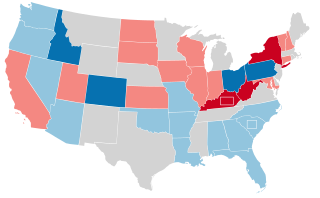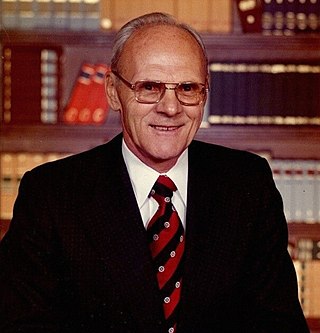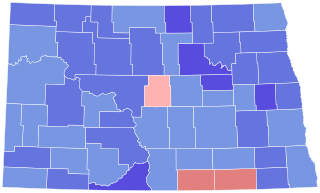
The 1992 United States Senate elections, held November 3, 1992, were elections for the United States Senate. The 34 seats of Class 3 were contested in regular elections, along with special elections to fill vacancies. They coincided with Bill Clinton's victory in the presidential election. This was the first time since 1956 that the balance of the Senate remained the same.

The 1988 United States Senate elections were elections for the United States Senate. Held on November 8, 1988, the 33 seats of Class 1 were contested in regular elections. In spite of the Republican victory by George H. W. Bush in the presidential election, the Democrats gained a net of 1 seat in the Senate. 7 seats changed parties, with 4 incumbents being defeated. The Democratic majority in the Senate increased by one to 55–45.

The 1982 United States Senate elections were held on November 2, 1982. They were elections for the United States Senate following Republican gains in 1980. The 33 Senate seats of Class 1 were up for election in 1982. A total of four seats changed hands between parties, with Democrats winning seats in New Jersey and New Mexico, and Republicans taking seats in Nevada and the seat of the lone independent, Senator Harry Byrd Jr., in Virginia. Democrats made a net gain of one seat bringing them to 46 seats, while Republicans stayed at 54 seats for a majority. However, the Democratic gain in New Jersey replaced a Republican that had been appointed earlier in the year. Liberal Republicans senators in Connecticut, Rhode Island and Vermont held onto their seats, keeping the Senate in Republican hands.

The 1976 United States Senate elections was an election for the United States Senate. Held on November 2, the 33 seats of Class 1 were contested in regular elections. They coincided with Democrat Jimmy Carter's presidential election and the United States Bicentennial celebration. Although almost half of the seats decided in this election changed parties, Carter's narrow victory did not provide coattails for the Democratic Party. Each party flipped seven Senate seats, although, one of the seats flipped by Democrats was previously held by a Conservative.

The 1974 United States Senate elections were held on November 5, with the 34 seats of Class 3 contested in regular elections. They occurred in the wake of the Watergate scandal, Richard M. Nixon's resignation from the presidency, and Gerald Ford's subsequent pardon of Nixon. Economic issues, specifically inflation and stagnation, were also a factor that contributed to Republican losses. As an immediate result of the November 1974 elections, Democrats made a net gain of three seats from the Republicans, as they defeated Republican incumbents in Colorado and Kentucky and picked up open seats in Florida and Vermont, while Republicans won the open seat in Nevada. Following the elections, at the beginning of the 94th U.S. Congress, the Democratic caucus controlled 60 seats, and the Republican caucus controlled 38 seats.

The 1970 United States Senate elections was an election for the United States Senate. It took place on November 3, with the 33 seats of Class 1 contested in regular elections. Special elections were also held to fill vacancies. These races occurred in the middle of Richard Nixon's first term as president. The Democrats lost a net of three seats, while the Republicans and the Conservative Party of New York picked up one net seat each, and former Democrat Harry F. Byrd Jr. was re-elected as an independent.

The 1968 United States Senate elections were elections for the United States Senate. Held on November 5, the 34 seats of Class 3 were contested in regular elections. They coincided with the presidential election of the same year. The Republicans picked up five net seats in the Senate. This saw Republicans win a Senate seat in Florida for the first time since Reconstruction.

The 1964 United States Senate elections were held on November 3. The 33 seats of Class 1 were contested in regular elections. Special elections were also held to fill vacancies. They coincided with the election of President Lyndon B. Johnson by an overwhelming majority, to a full term. His Democratic Party picked up a net two seats from the Republicans. As of 2023, this was the last time either party has had a two-thirds majority in the Senate, which allowed the Senate Democrats to override a veto, propose constitutional amendments, or convict and expel certain officials without any votes from Senate Republicans. However, internal divisions would have prevented the Democrats from having done so. The Senate election cycle coincided with Democratic gains in the House in the same year.

The 1960 United States Senate elections coincided with the election of John F. Kennedy as president on November 8, 1960. The 33 seats of Class 2 were contested in regular elections. A special election was also held on June 28, 1960, for a mid-term vacancy in North Dakota where Democrats flipped a seat to expand their majority to 66–34. As Majority Leader Lyndon Johnson was elected Vice President, Mike Mansfield became the new majority leader.

The 1956 United States Senate elections were elections for the United States Senate that coincided with the re-election of President Dwight D. Eisenhower. The 32 seats of Class 3 were contested in regular elections, and three special elections were held to fill vacancies. Although Democrats gained two seats in regular elections, the Republicans gained two seats in special elections, leaving the party balance of the chamber unchanged.

The 1946 United States Senate elections were held November 5, 1946, in the middle of Democratic President Harry S. Truman's first term after Roosevelt's passing. The 32 seats of Class 1 were contested in regular elections, and four special elections were held to fill vacancies. The Republicans took control of the Senate by picking up twelve seats, mostly from the Democrats. This was the first time since 1932 that the Republicans had held the Senate, recovering from a low of 16 seats following the 1936 Senate elections.

Quentin Northrup Burdick was an American lawyer and politician. A member of the North Dakota Democratic-NPL Party, he represented North Dakota in the U.S. House of Representatives (1959–1960) and the U.S. Senate (1960–1992). At the time of his death, he was the third longest-serving senator among current members of the Senate.

Thomas Savig Kleppe was an American politician who served as the Representative from North Dakota. He was also the Administrator of the Small Business Administration and the U.S. Secretary of the Interior.

The 1988 U.S. Senate election for the state of North Dakota was held November 8, 1988. Incumbent (Democratic-NPL Senator Quentin Burdick won re-election to his sixth term, defeating Republican candidate Earl Strinden.

The 1982 U.S. Senate election for the state of North Dakota was held November 2, 1982. The incumbent, North Dakota Democratic NPL Party (Dem-NPL) Senator Quentin Burdick, sought and received re-election to his fifth term, defeating Republican candidate Gene Knorr.

The 1976 U.S. Senate election for the state of North Dakota was held November 2, 1976. The incumbent, North Dakota Democratic NPL Party (Dem-NPL) Senator Quentin Burdick, sought and received re-election to his fourth term to the United States Senate, defeating Republican candidate Robert Stroup.

The 1964 U.S. Senate election for the state of North Dakota was held November 3, 1964. The incumbent, Dem-NPL Senator Quentin Burdick, sought and received re-election to his second term, defeating Republican candidate Thomas S. Kleppe, who later became the United States Secretary of the Interior.

The 1974 United States Senate election in North Dakota was held November 5, 1974. Incumbent Republican U.S. Senator Milton Young was narrowly reelected to his sixth term, defeating Democratic-NPL candidate William L. Guy.

The 1960 Special U.S. Senate election in North Dakota was held June 28, 1960, to fill the United States Senate seat vacated by the late William Langer. Langer died in office on November 8, 1959, and Clarence Norman Brunsdale, a former Governor of North Dakota, was temporarily appointed to the seat on November 19 of that year until the special election was held. North Dakota Democratic-NPL Party candidate Quentin N. Burdick faced Republican John E. Davis for election to the seat. Davis had been serving as Governor of the state since 1957.

The 1956 U.S. Senate election in North Dakota was held November 6, 1956. The incumbent, Republican Senator Milton Young, sought and received re-election to his third term, defeating North Dakota Democratic-NPL Party candidate Quentin N. Burdick, son of North Dakota congressman Usher L. Burdick.























